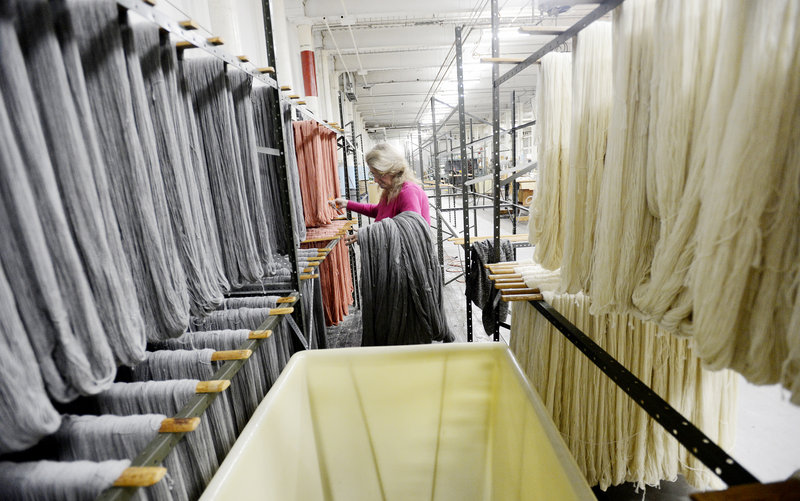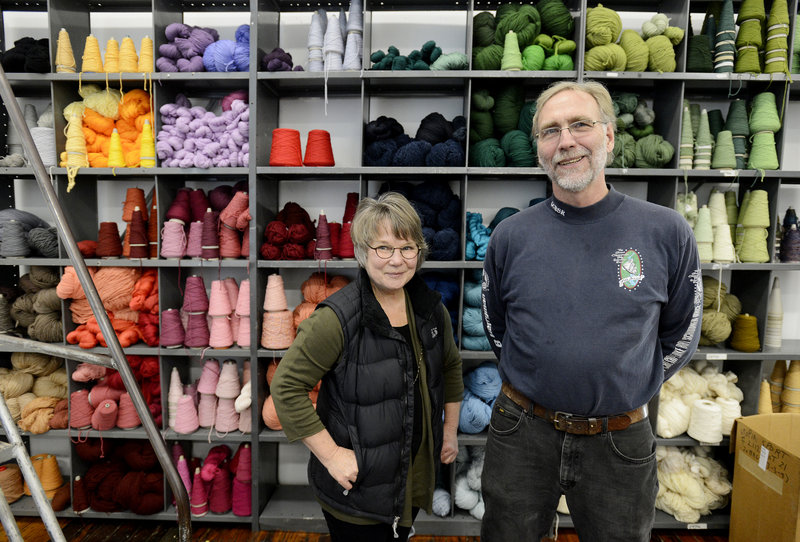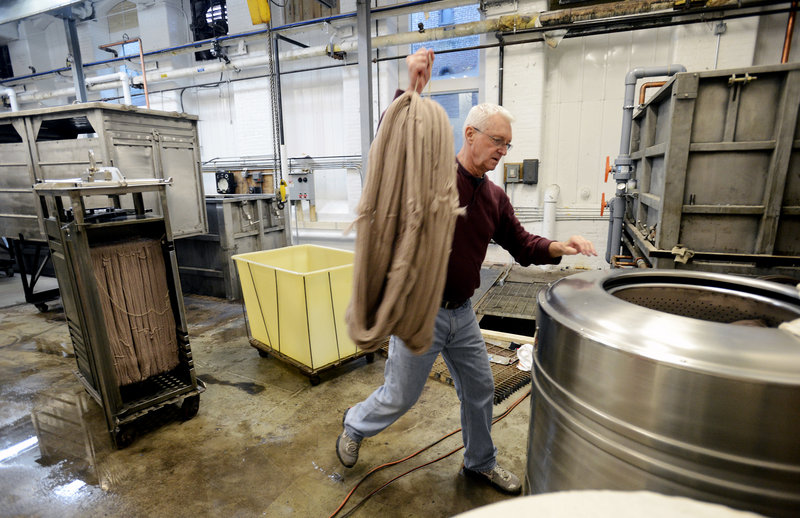BIDDEFORD – Dye master Don Morton slowly lifted a rack out of a dye tank, steam curling toward the ceiling as he removed the loops of yarn inside.
It was the last batch of the day and among the first 600 pounds of yarn dyed in the new Saco River Dyehouse.
“Right now we’re taking baby steps,” Morton said as he moved skeins of yarn into a machine to extract water. Nearby, an employee hung damp skeins on racks to dry overnight while another worker used a small machine to twist skeins dyed the previous day.
The opening of the Saco River Dyehouse this month marks the rebirth of a midsize dyeing operation formerly based in Massachusetts and the return of textile-related manufacturing to the sprawling mill complex on the banks of the Saco River.
The labor-intensive yarn dyeing operation, opened by Maine Textiles International LLC, is in the same location as the dye house that formerly served WestPoint Home, a blanket manufacturer that closed in 2009, temporarily bringing to an end the city’s 150-year textile manufacturing tradition.
In time, operators hope to dye 20,000 pounds of yarn per month for customers across the country.
The idea to bring the dye house to Maine was sparked last spring after the JCA dye house in Pepperell, Mass., closed, forcing Maine yarn producers to look elsewhere for dyeing services. Claudia Raessler, who owns alpaca fiber company SuriPaco, contacted Pam Allen of Quince & Co. in Portland about the possibility of acquiring JCA’s assets and opening an organic dye house in Maine. After the JCA dye house closed, Allen was forced to ship her wool yarn to Philadelphia to be dyed, a more expensive arrangement.
“It’s one of those things that picked up its own momentum,” Allen said of the decision to buy JCA’s equipment and reassemble the dye house in Maine. “This is a dream come true.”
Allen and Raessler teamed up with Raessler’s husband, Ken, and Nick Burnett to form Maine Textiles International and run the dye house. They needed a large space to accommodate the business and quickly focused their search on the Pepperell Mill Campus in Biddeford.
“The draw was twofold: there was natural gas and the former Pepperell Mill dye house was behind these doors,” Raessler said as she stood in the cavernous mill building just off Main Street.
Moving into the mill is fitting because that wing of Building 13-1 had the infrastructure for a dye house, Raessler said. The dyeing operation, set up in a leased 18,000-square-foot space, requires a huge steam boiler and space for large vats and drying racks. Soon the dye house operation will include a space for a retail store and knitting lessons.
Morton, who has worked in the industry since the 1960s, said the mill building is a perfect fit for the Saco River Dyehouse.
“I’m totally overwhelmed at the size of the building and what it must have been like in its heyday,” Morton said. At one time, the building housed 1,500 looms.
Doug Sanford, owner and developer of the Pepperell Mill Campus, said he sees the arrival of the dye house as the first step toward establishing a textile hub of similar businesses in the mills.
“It’s opened up all new potential and opportunities,” he said. “I think it’s just super exciting.”
Raessler agrees bringing the dye house to Maine is exciting, but said it hasn’t been without its challenges. She was surprised to find a shortage of workers trained to work in textile manufacturing in a community that for generations relied on that very industry. Many former mill workers retired after losing their jobs, she said. She is now talking to York County Community College about putting together a certificate program for textile machine operators.
The Saco River Dyehouse has hired seven full-time employees and foresees growing to 15 employees in 18 months.
Morton, the dye master, worked at JCA and agreed to come to Biddeford to help get the dye house up and running. He’ll stay on with the company as they work to find an apprentice to train as another dye master.
“They’re like gems, they’re hard to find. It’s part art and part science,” Raessler said. “You have to have an eye for it.”
Raessler and Burnett, the operations manager, said the dye house has been welcomed enthusiastically by the community.
“No matter who we talk to in town, when we tell them we’re bringing textiles back, they’re so happy,” Burnett said.
“The community response to this is tremendous,” Raessler added. “I think the mill was the heart and soul of this community for a long, long time.”
Staff Writer Gillian Graham can be contacted at 791-6315 or at:
ggraham@mainetoday.com
Twitter: grahamgillian
Send questions/comments to the editors.







Success. Please wait for the page to reload. If the page does not reload within 5 seconds, please refresh the page.
Enter your email and password to access comments.
Hi, to comment on stories you must . This profile is in addition to your subscription and website login.
Already have a commenting profile? .
Invalid username/password.
Please check your email to confirm and complete your registration.
Only subscribers are eligible to post comments. Please subscribe or login first for digital access. Here’s why.
Use the form below to reset your password. When you've submitted your account email, we will send an email with a reset code.